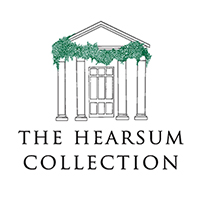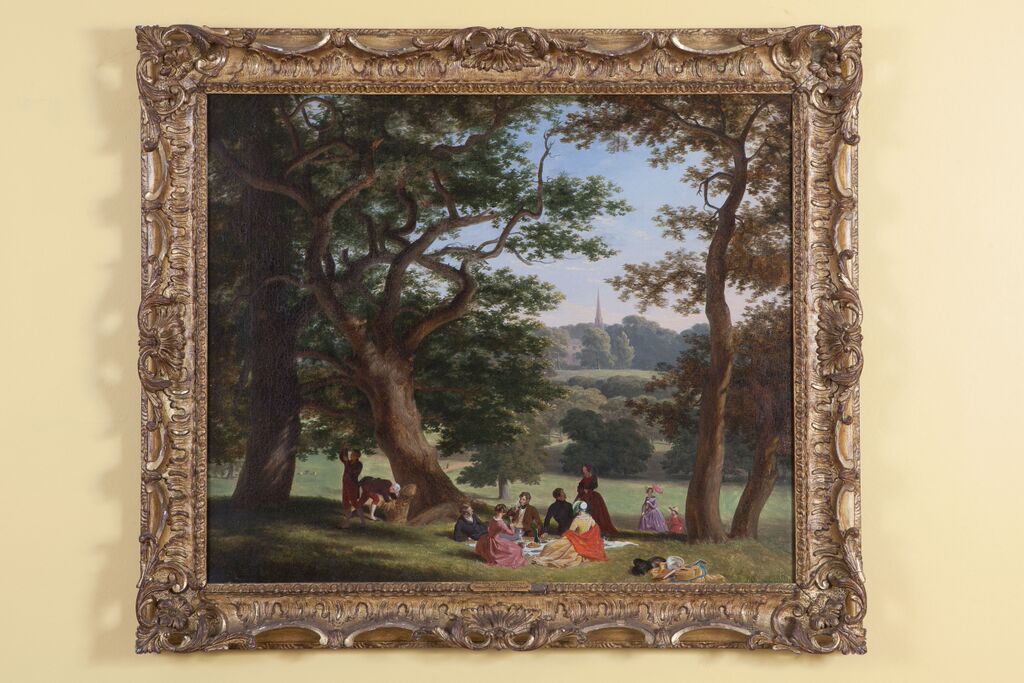There are so many interesting items in the Hearsum Collection but one painting particularly caught my eye. It is a lovely depiction of Richmond Park but, more importantly for me, it has links to Ham House, the seat of the Dysart family from the 17th century through to the 20th century (when it was passed to The National Trust) and the place where I work.
What I love most about the image is that it shows a family of the 19th century doing exactly what you will see families doing every day in the Park today.
The painting is by William Frederick Witherington (1785-1865), a British artist who was a member of the Royal Academy (1840) and exhibited there between 1811 and 1863.
Although the work is not dated, the dress of the figures in the painting and the style suggest it could be towards the middle of the 19th century when the 8th Earl of Dysart was head of the family. The costumes seem to suggest this era and also the fact that the three young men depicted in the painting are very possibly the 8th Earl and his younger brothers, Frederick and Algernon.
By 1842, the 8th Earl had become somewhat eccentric and asked Frederick and Algernon to live at Ham House and take up the management of his estates. He took up residence at 34 Norfolk Street in London where he eventually confined himself to one room with a trapdoor for food etc., to be passed through. He became known as “The Hermit of Norfolk Street”, allowing no one into the room except his brother Frederick. An incident which highlights his eccentricity was reported when his boot-maker was summoned to measure him for new boots. According to the story, “he thrust one leg out through the trapdoor, and when asked how many pairs he required, answered that he only wanted one boot, there was nothing the matter with the other one!”
Another point of uncertainty and discussion which the painting has thrown up is the church steeple depicted in the background of the painting. Those who are familiar with the Park would probably first think of St Matthias, on Richmond Hill, with a matching steeple which can be seen very clearly from various points of the Park on the Richmond side. However, research into this shows that St Matthias was not completed until 1857 when the artist would have been 72 and, although still exhibiting at this time, his body of work suggests most of it was done earlier in his life. Added to that and perhaps more of an issue is that the lay of the land is quite different.
Then there is the church in Roehampton to consider, also with a similar steeple visible from the Roehampton side of the Park, but once again the dates prove this not to be a contender as it was built around 30 years after Witherington’s death.
Having gone back to study a larger copy of the painting I believe a more likely possibility would be that we are looking behind the characters in the painting over the path from Ham Cross towards Ham. The land falls away from the higher grounds on the Pembroke Lodge side to look down towards the pond, and the path fits the bill. The obvious church, which could have been more visible in the 19th century, is the parish church of St Andrew’s. Unfortunately, St Andrew’s does not have a steeple!
The investigations continue to establish whether any of the possibilities mentioned had previous churches, or indeed steeples, on the sites or thereabout. Whatever the answer turns out to be as to the inspiration behind the painting’s vista, I feel the surrounding landscape, and particularly the size of the steeple, suggest more than a soupçon of artistic licence.
In fact I can say with some conviction that Witherington was not averse to painting church steeples out of place or where they were not! Having viewed another of his paintings held at Petworth House in West Sussex, I found out that in “Fête in Petworth Park”, painted in 1835, there is a church steeple which had indeed been built, albeit against the advice of the architect, but had fallen down long before the painting had been started.
Like so many of the items in the Collection this painting gives us not only a glimpse of the Park’s history but also links us to the present day and how we enjoy the Park now; that it is part of the Collection at all is a story in its own right, for the acquisition was no mean feat. Daniel Hearsum tells me: “In November 2012, we were alerted to the forthcoming auction of this painting by an internet search alert and on checking its provenance, registered to bid. The only problem was that the auction was in Portsmouth, New Hampshire in the United States and so international telephone bidding was required. On the day, we were bid up and up, not knowing how real the competition was. Nonetheless, we won and over the telephone heard an excited exclamation to the auction room, in a voice reminiscent of ET, ‘Listen everybody, It’s going home, It’s going home to Richmond Park in the United Kingdom’ – followed by loud applause. It seems our cousins in New England approve of repatriation!”
Annie Sullivan
Friends of Richmond Park History Project Volunteer
2 July 2015

